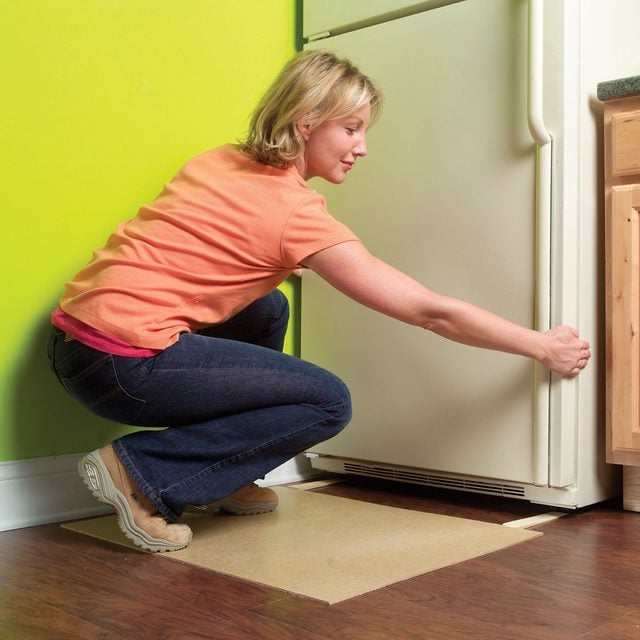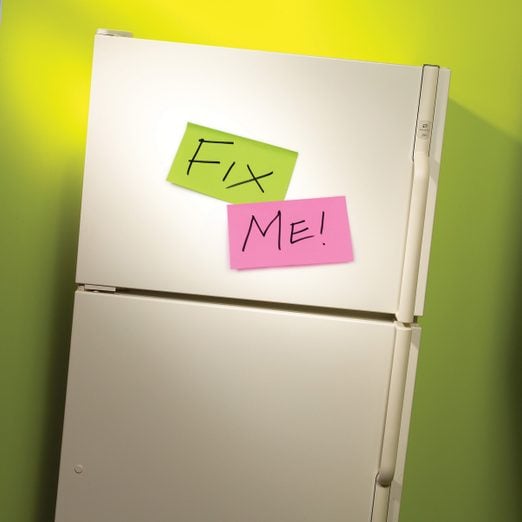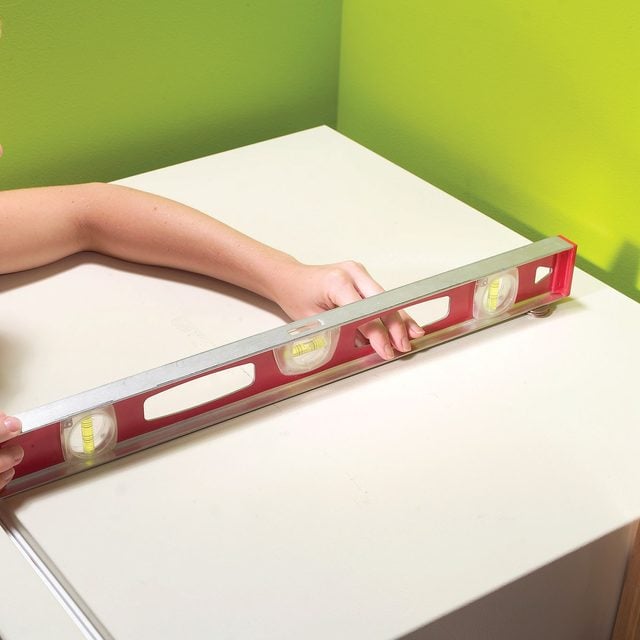How to Repair a Refrigerator
Updated: Jan. 10, 2023
Fix the most common fridge problems yourself — and save the expense of a service call!
A full day
Beginner
Less than $20
Introduction
Learn simple fixes for the four most common refrigerator problems: an ice maker breakdown, water leaking onto the floor, a cooling failure and too much noise.Tools Required
- 4-in-1 screwdriver
- Adjustable wrench
- Hair dryer
- Level
- Long brush
- Nut driver
- Vacuum
Fixing Common Refrigerator Problems
Chances are, you can solve a refrigerator repair yourself, save some money and avoid the expense and inconvenience of a service appointment. The following article will walk you through the simplest solutions to the most common fridge malfunctions.
Plus, check out these simple fixes for common appliance problems.
Project step-by-step (23)
Step 1
Refrigerator Repair Problem: Ice Maker on Strike
- Instead of looking up “refrigerator service near me,” use this guide to fix your refrigerator yourself.
- When an ice maker stops working or produces only tiny cubes—or even produces gray ice—it’s usually because the water supply is partially or completely blocked.
- To find and fix the blockage, check out the three common trouble spots. We’ll go into more detail in the steps below.

Step 2
Easy Fixes for an Ice Maker
- To begin, check the water inlet tube for ice.
- Pro tip: The tube that supplies water to your ice maker can get plugged with ice when the water pressure is low. The trickling water freezes and plugs the tube before it reaches the ice maker.
- To remove the ice maker, take out the screws that hold the ice maker in place.
- Unplug the wiring harness and remove the ice maker to expose the water inlet tube.
Always unplug the refrigerator before you make any repairs.
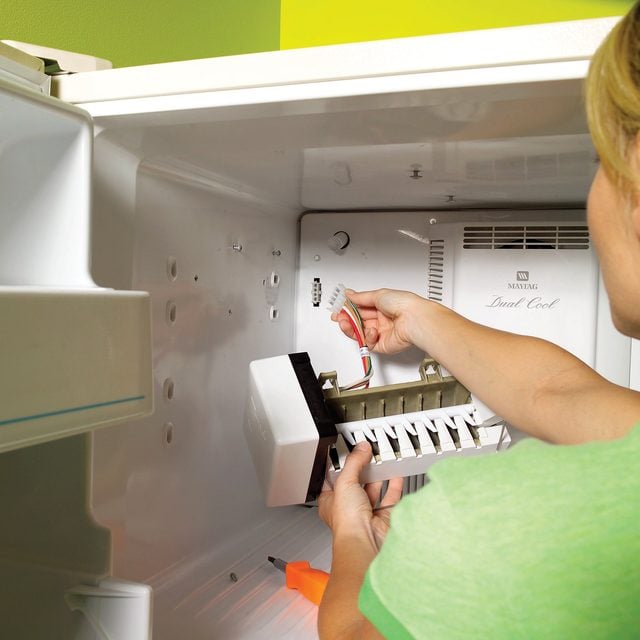
Step 3
Melt the Ice
- Melt the ice in the water inlet tube with a hair dryer.
- Don’t stop until water stops dripping from the tube.
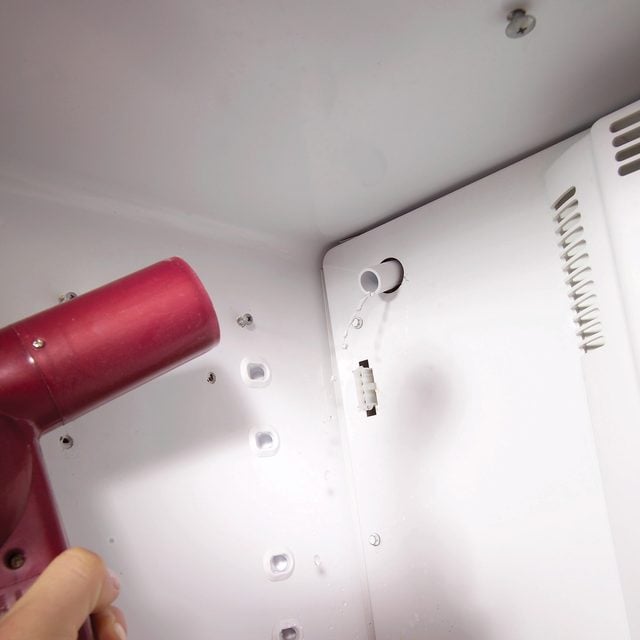
Step 4
Unblock the Saddle Valve
- Most ice makers are connected to the household water supply by a “saddle” valve. One problem with saddle valves is that the needle hole in the pipe can clog.
- Fortunately, that blockage is easy to clear once you locate the saddle valve.
- Pro tip: If you have an unfinished basement, you’ll probably find a tube beneath the fridge that leads to the valve. Otherwise, look under your kitchen sink.
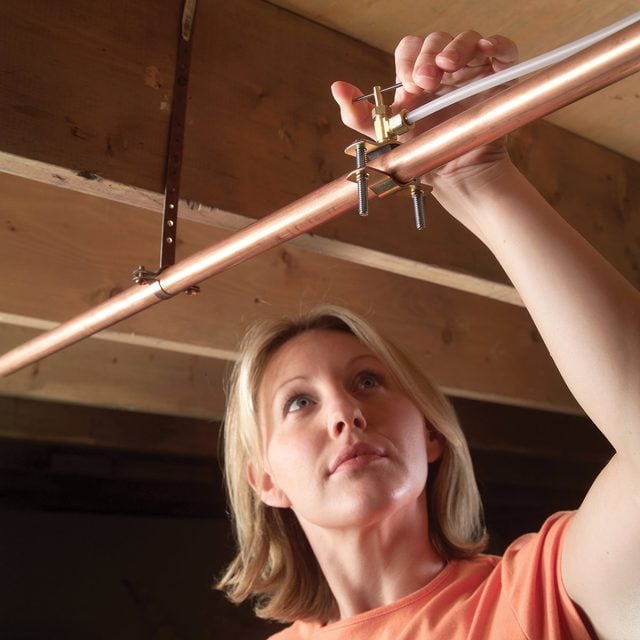
Step 5
Close-Up of a Saddle Valve
- Turn the saddle valve clockwise to unblock it.
- Firmly tighten it to clear mineral deposits from the pinhole.
- Then reopen the valve.
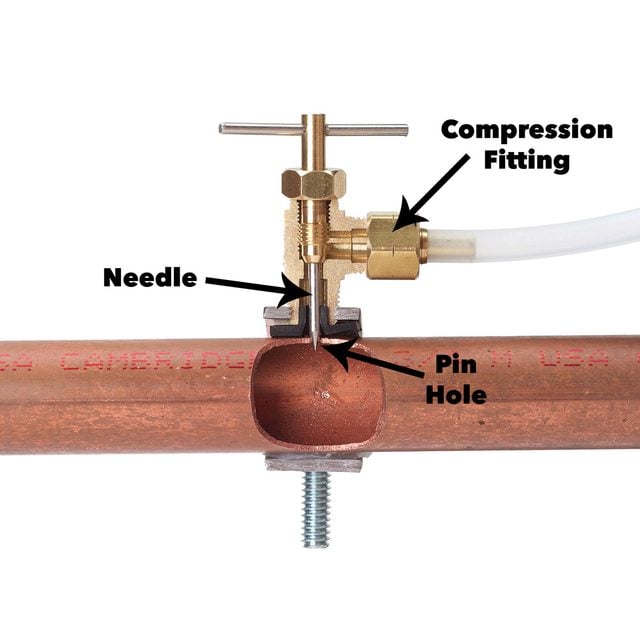
Step 6
Replace the Inlet Valve
- At the back of your fridge, there’s a small electric “inlet valve” that turns the water supply to the ice maker on and off.
- Pro tip: Before you replace the valve, make sure water is flowing to it. Turn off the water at the saddle valve and disconnect the supply tube from the inlet valve.
- Hold the tube over a bucket and have a helper turn on the saddle valve.
- Pro tip: If water flows out of the tube, the water supply is fine and chances are the inlet valve is bad.
- To replace the inlet valve, unscrew the cover panel and remove the screws that hold the valve in place.
- Unplug the wiring and unscrew the nuts that connect the water lines.
- Reverse these steps to install the new valve.
- When the job is done, turn the water back on and check for leaks before you push the fridge back into place.
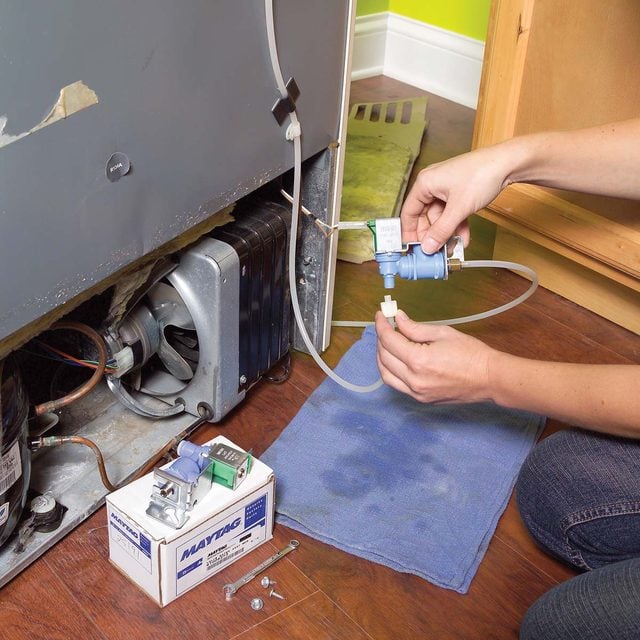
Step 7
Refrigerator Repair Problem: The Fridge Produces Puddles
- The water supply lines that serve ice makers or water dispensers can leak and make pools under the fridge. But a fridge without these features can create water problems too.
- Every fridge produces water in the form of condensation and melting ice.
- When the system that deals with this water fails, you can end up with puddles inside and outside of the fridge.
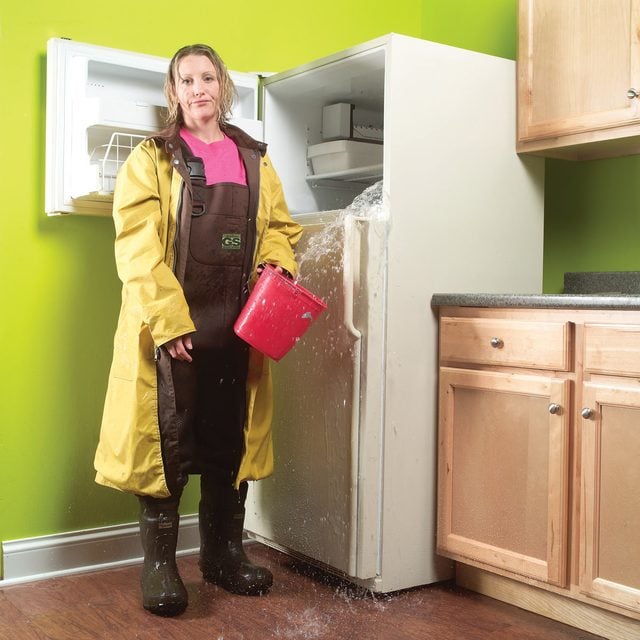
Step 8
Leak-Prone Parts of a Compression Fitting
- First, check the water supply line.
- If your fridge has an ice maker or water dispenser, pull out the fridge and look for a leak.
- If there’s a leak at the inlet valve, tighten the compression nuts.
- If the plastic or copper tube is leaking, replace it.
- Pro tip: Tubing is usually connected to the saddle valve and inlet valve with screw on compression fittings.
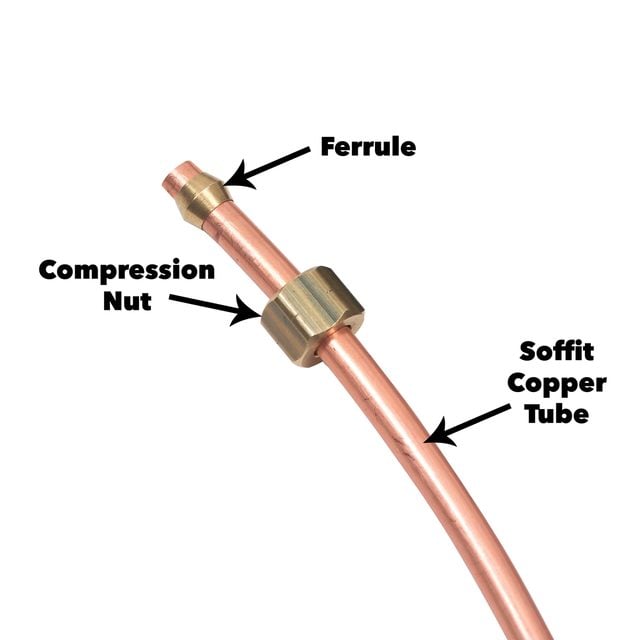
Step 9
Check the Fridge With a Level
- Water drains into a pan under the fridge where it evaporates. If your fridge is badly tilted, water can spill out of the pan. Leveling the fridge solves this problem.
- To level the fridge, adjust the fridge so it’s level from side to side and tilted backward.
- Stack quarters near the back and set a two-foot level on them.
- When the bubble shows level, the tilt is correct.
Step 10
Use the Adjustment Screws
- Pull off the front cover grille to level or tilt the fridge.
- Turn adjustment screws to raise or lower the front corners of the fridge.
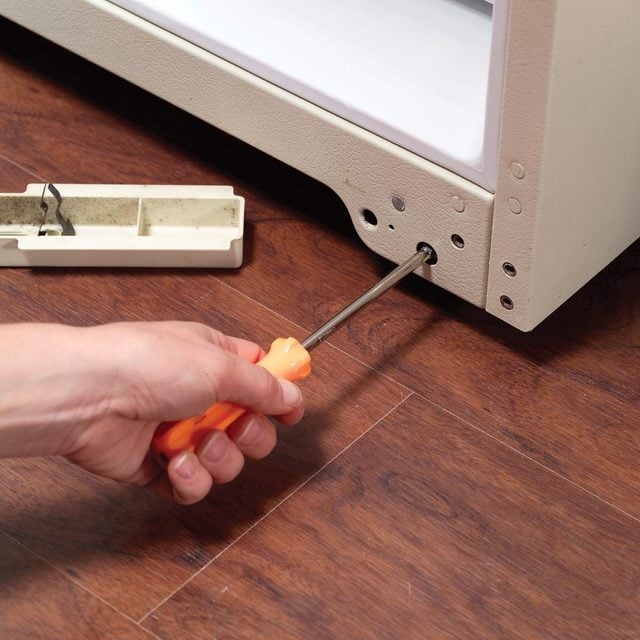
Step 11
Lift the Back Cover Panel
- If the drain tube in the freezer gets plugged, water leaks into the compartment below or onto the floor.
- To unplug it, first remove the cover panel.
- Remove the screws that hold the back cover panel in place.
- On some models, you have to pry out plastic screw covers with a putty knife to expose the screws for freezer repair. In some models, you have to unscrew the floor panel too.
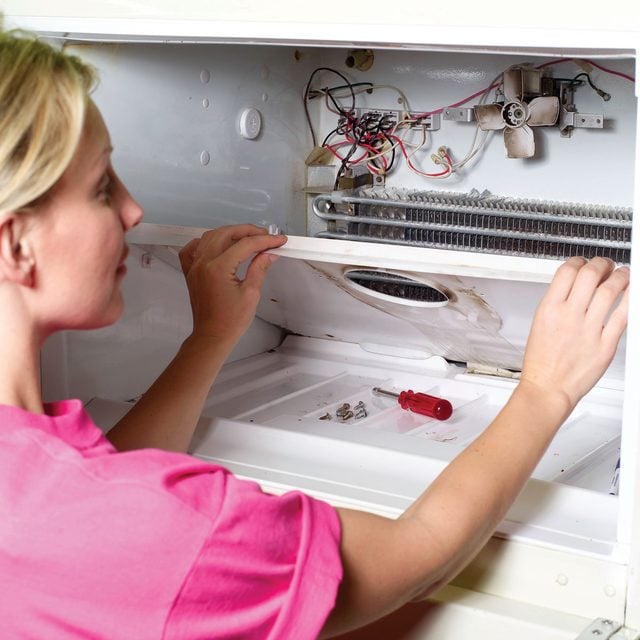
Step 12
Clear the Drain Hole
- Use a hair dryer to melt any ice buildup.
- Sop away the melt water with a sponge. Then clean up around the drain hole.
- Insert a tube in the drain hole and blow out any debris for freezer repair.
- Pro tip: Any tube that fits tightly into the hole will work. You can also use a tire pump or air compressor (turn the pressure down to 30 psi).
- Pour a cup of water into the tube to make sure it drains before you replace the cover panel.
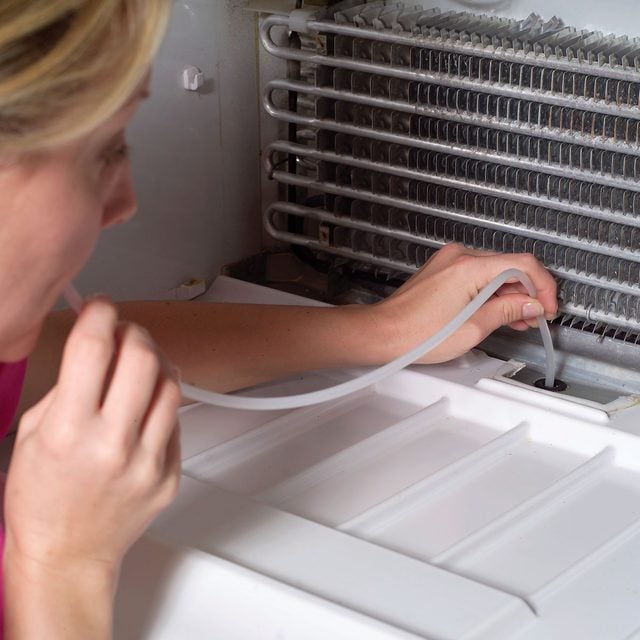
Step 13
Refrigerator Repair Problem: Fridge or Freezer Won’t Cool
- There are lots of malfunctions that will cause your freezer to stop freezing items.
- One common cause of suddenly soft ice cream or warm juice is a simple loss of electricity.
- If the light doesn’t come on when you open the fridge door, make sure the fridge is plugged in and check the breaker panel.
- If the fridge runs but doesn’t get cold enough, chances are one of the following fixes will restore the chill.
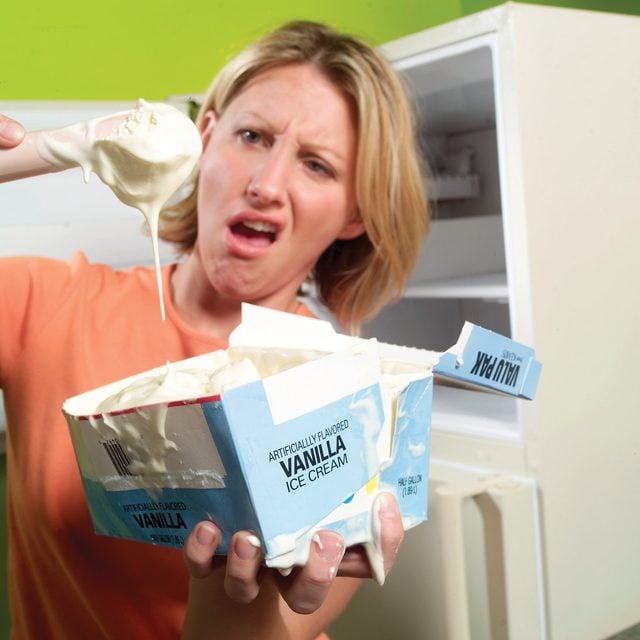
Step 14
Check the Temperature Control Dial
- First, check the thermostat and vents. The temperature control dial inside the fridge is sometimes irresistible to curious kids.
- Make sure it hasn’t been turned way down.
- Also make sure the vents in the fridge and freezer compartment aren’t blocked by food containers. These vents supply the flow of frigid air.
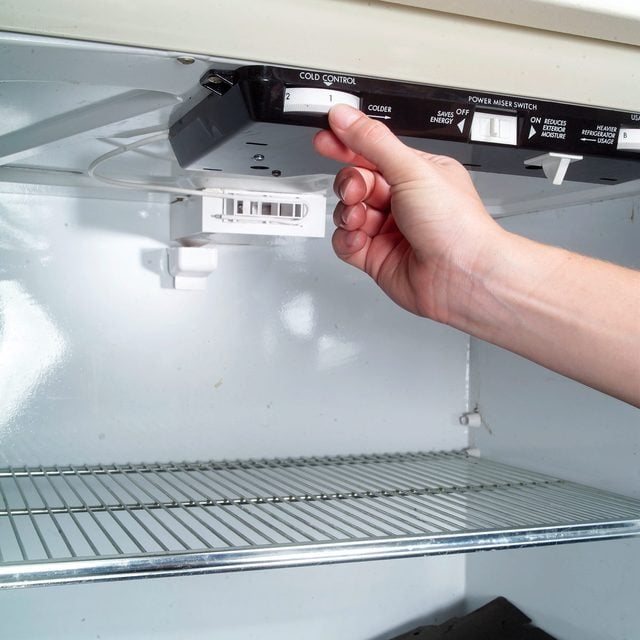
Step 15
Clean the Coils
- In order for your fridge to create a chill, air has to flow freely through the condenser coils. On most older refrigerators, these coils are on the backside.
- Cereal boxes on top of the fridge or grocery bags stuffed behind it can reduce the needed airflow.
- Most newer refrigerators have coils underneath, where they can be blocked by trash and clogged with dust.
- Even if your fridge is working fine, you should pull off the front grille and clean the coils every year for efficient operation. Do it every six months if you have shedding pets.
- Long brushes are available at appliance stores for $8.
- Clean the coils so air can flow through them.
- Pull dust and fur balls from beneath and between coils with a long brush.
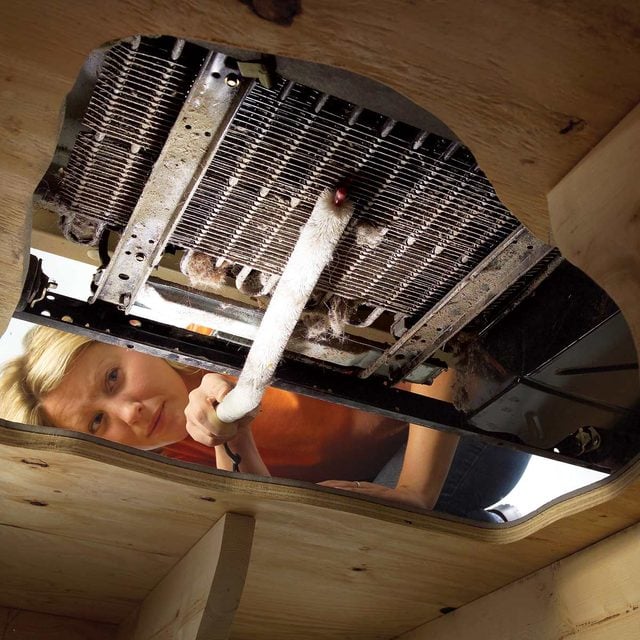
Step 16
Vacuum the Fan
- Coils on the back of a fridge create their own airflow as they heat up.
- Models with coils underneath have a fan to push air through them.
- Dust buildup can slow the fan. Wads of paper or other trash can stop it altogether.
- Pull out the fridge and unscrew the cover panel.
- Vacuum the fan. Then start the refrigerator to make sure the fan turns freely.
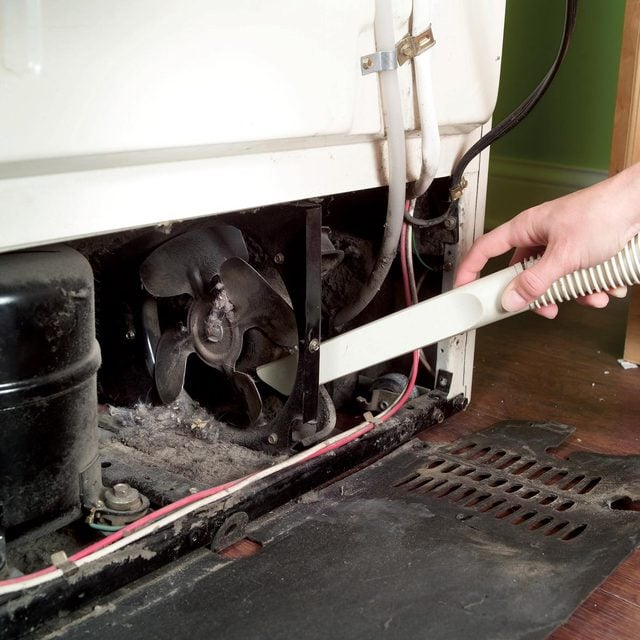
Step 17
Diagnose a Bum Refrigerator Circuit Board
- If your refrigerator isn’t keeping food cold, the cause could be a burned circuit board or a sticking circuit board relay.
- Before calling for repair service, try this trick.
- Unplug the fridge and roll it out.
- Remove any metal cover plates or cardboard access panels on the back and look for a circuit board.
- Examine the board for burn marks. If you see any, replace them.
- Move the press-on connectors to the new board one at a time.
- Press each connector onto the header pins until it’s firmly seated.
- If the board looks good, locate the largest relay on the board (look for the largest rectangular plastic box).
- Then plug in the fridge (don’t touch any wires!). Tap lightly on the compressor relay to rattle the electrical contacts inside.
- If the fridge starts, you need a new circuit board.
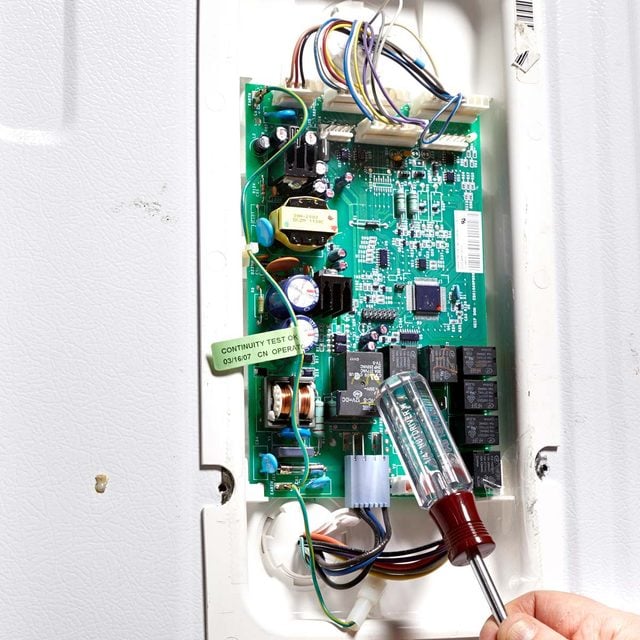
Step 18
Replace a Bum Refrigerator Circuit Board
- If there are no burn marks and the tapping doesn’t work, or the compressor makes a humming or clicking sound and then shuts off, the problem may be a relay located on the compressor itself.
- To learn how to do that fix, see refrigerator compressor repair.
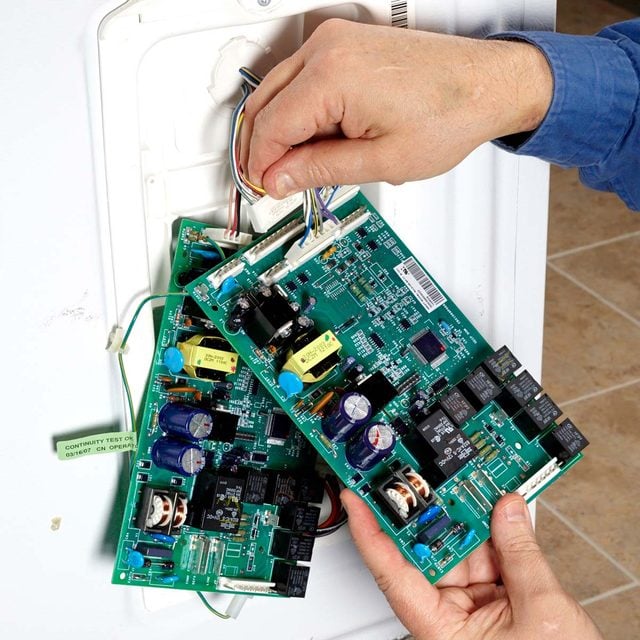
Step 19
Refrigerator Repair Problem: A Noisy Fridge
- Refrigerator noise comes from the compressor under the fridge, the condenser fan motor under the fridge, or the evaporator fan motor inside the freezer.
- Open the freezer door while the fridge is running. If the noise doesn’t get louder when you open the freezer, pull out the fridge.
- Most refrigerators have a condenser fan motor. Unscrew the back cover and listen. You’ll be able to tell whether the noise is coming from the fan or the compressor.
- The best cure for a loud compressor is usually a new fridge.
- To replace the fan motor, remove its mounting screws, unplug it and install the new one.

Step 20
Remove the Fan
- If the sound gets louder when you open the freezer, the evaporator fan motor is the noisy culprit. This refrigerator motor is easy to replace.
- Your fan may not look exactly like the fan we show here, but the basic steps are the same.
- Unscrew the fan from the rear wall of the freezer and unplug the wires.
- With some models, you’ll need a socket set or nut driver to remove the fan.
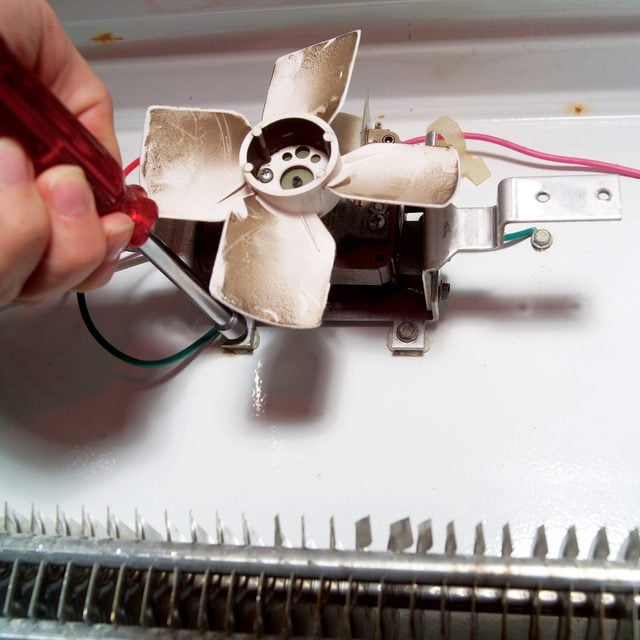
Step 21
Replace the Old Fan
- Remove the fan refrigerator motor from its mounting bracket.
- Fasten the new fan to the mounting bracket, reconnect the wires and screw the new fan into place.
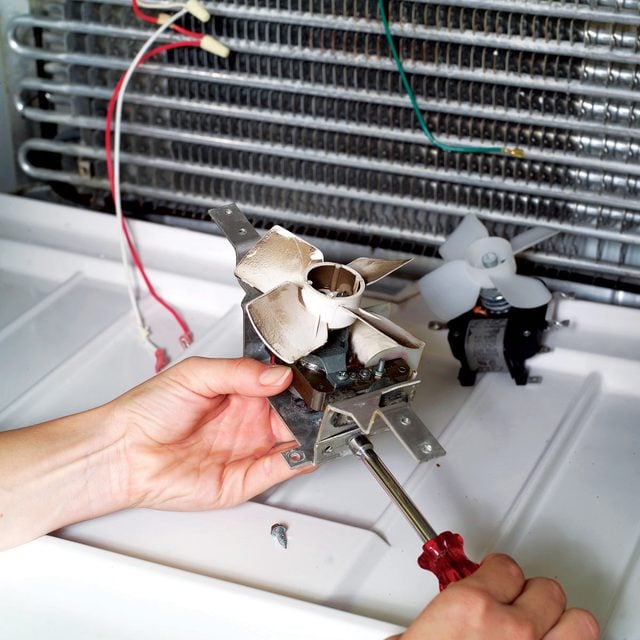
Step 22
Finding Fridge Parts
- To get the right part for your refrigerator, you’ll need the model number, which is usually stamped on a tag inside the fridge. If you can’t find it anywhere on or inside the fridge, check your owner’s manual.
- To locate a parts dealer in your area, search “Appliances, Major, Parts near me.”
- To mail-order parts for any major brand, go to www.sears.com or call (800) 4-MY-HOME.
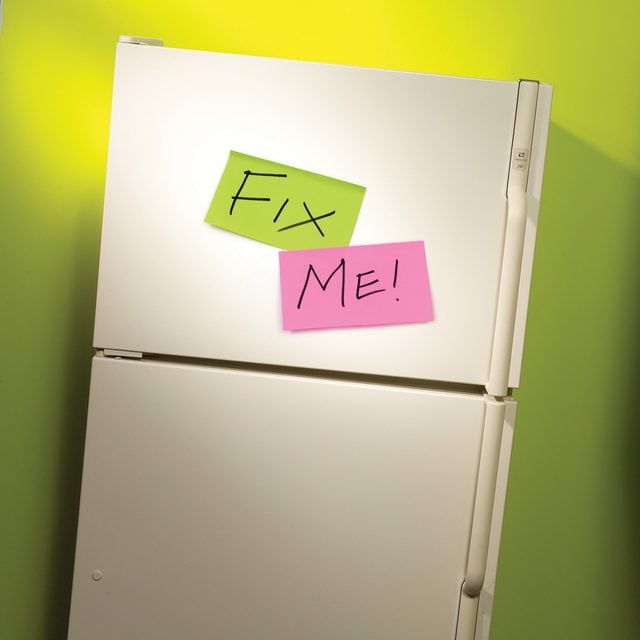
Step 23
Don’t Wreck The Floor When You Pull Out The Fridge
- Nine times out of ten, you can pull out a fridge without any damage to the floor.
- But a sideways skid or a grain of sand caught under a wheel can scar any floor.
- At the very least, lay down a cardboard runway before dragging out your fridge.
- For the ultimate floor protection, use 1/8-in. hardboard (at home centers).
- A pair of shims create a ramp for easier pulling.
